Smart Rings: The Tiny Wearables Making a Big Impact
14 July 2025
Wearables have come a long way from chunky wristbands and futuristic headsets. These days, the latest buzz in tech isn’t sitting on your wrist or wrapped around your head—it's wrapped around your finger. Yep, we're talking about smart rings—sleek, subtle, and surprisingly powerful little gadgets that are changing the game.
If you thought wearables were limited to tracking steps and pushing notifications, think again. Smart rings are here to do it all—and then some—while staying lowkey and stylish. Whether you're a fitness junkie, a health nerd, or just someone who likes their tech to be tiny and smart, these futuristic rings might just be your next favorite gadget.
Let’s dive into how these pint-sized powerhouses are making a massive impact.
What Exactly Is a Smart Ring?
Good question. Simply put, a smart ring is a wearable electronic device designed in the form of a finger ring. Inside this unassuming circle lies a treasure trove of technology—think sensors, batteries, Bluetooth modules, and in some cases, even NFC chips.Despite their size, smart rings can track a range of data including:
- Heart rate
- Blood oxygen levels (SpO2)
- Sleep cycles
- Body temperature
- Step count and activity levels
- Even stress and recovery rates
Sounds like a mini fitness tracker, right? But sleeker. And cooler.
Why Smart Rings Are Gaining So Much Hype
Let’s face it—smartwatches are cool, but not everyone likes the look or feel of them. That’s where smart rings step in. Think of smart rings as the introverted geniuses of the wearable world. They don’t scream "tech" at first glance, but they quietly get everything done under the surface.Here’s why many people are making the switch or even using them alongside a smartwatch:
1. Minimalist Aesthetics
A ring doesn’t interrupt your daily fashion choices. Unlike wrist-based wearables that can clash with outfits or feel bulky during workouts, smart rings are discreet and stylish. They can even pass off as regular jewelry.2. All-Day (and Night) Wearability
Smart rings are ultra-light, which means you can wear them while sleeping without feeling like you’re lugging around hardware. Since sleep tracking is one of their strong suits, comfort during the night is a big win.3. Long Battery Life
Smart rings often outlast their smartwatch cousins. Thanks to their simple interface (no screens, fewer notifications), many rings can go 4–7 days—or more—on a single charge. That’s peace of mind you don’t get with daily charging rituals.4. Focus on Health & Performance Metrics
Rather than trying to offer a million features, smart rings typically double down on what matters: your health. With accurate sensors and detailed data, they’re designed for folks who genuinely care about wellness and performance optimization.
Top Features Packed in a Tiny Package
You might be wondering, “How much tech can you really cram into something the size of a wedding band?”You’d be surprised.
💤 Sleep Tracking Like Never Before
Smart rings are arguably the best wearable form factor for sleep monitoring. Rings like the Oura Ring and Ultrahuman Ring AIR track your complete sleep cycles—light, deep, and REM. Some also monitor restlessness, heart rate variability (HRV), and nighttime oxygen levels.This data can help you recognize patterns affecting your sleep, from your late-night Netflix binges to caffeine-happy habits.
❤️ Heart and Health Monitoring
Using optical sensors and PPG (photoplethysmography), smart rings monitor resting heart rate, HRV, and sometimes even blood oxygen saturation. This can help you keep an eye on stress levels and overall cardiovascular health.🔋 Recovery and Readiness Scores
Many smart rings provide a "readiness" score based on how well you’ve rested and other key health metrics. Think of it as your body's daily performance report card. Should you hit the weights or rest today? Your ring's got the answer.💪 Activity and Fitness Tracking
While smart rings may not replace hardcore fitness watches just yet, they do cover the basics such as steps, distance moved, calories burned, and overall activity levels. Plus, since they don’t weigh down your wrist, they’re perfect for lighter workouts like yoga, walking, or Pilates.
Popular Smart Rings on the Market (and What Makes Them Special)
The smart ring market is still boutique compared to smartwatches, but it's growing fast. Here are a few standout players:🔹 Oura Ring (Gen 3)
Arguably the most famous smart ring out there. It’s minimal, stylish, and packed with sensors. The Gen 3 can track sleep, readiness, temperature trends, HRV, and blood oxygen. What’s more, the Oura app breaks all this data into digestible insights.🔹 Ultrahuman Ring AIR
A strong contender, especially for those serious about body optimization. It's focused on metabolic health and recovery, offering glucose monitoring when paired with a CGM sensor.🔹 RingConn
RingConn aims to offer health tracking without monthly subscriptions—something Oura doesn’t do (unless you stick with the basics). It’s lighter than many of its peers and is all about comfort and clean UX.🔹 Circular Ring
This one blends health tracking with smart notifications (yes, you can get alerts on your finger). It’s nice for folks who still want some smartwatch vibes—but way more subtle.Smart Rings vs Smartwatches: Which One Wins?
Tough call, honestly.If you're into quick replies, navigation, and having a screen on-hand (or on-wrist), then a smartwatch still reigns supreme. But if you're focused more on health, biofeedback, and low-key wearability, a smart ring might be your best bud.
💡 Pro tip: Many users are starting to double up—pairing a smartwatch for daytime use with a smart ring for nighttime and health tracking. It's not an either-or situation.
Are Smart Rings Actually Accurate?
Great question, and it's one worth digging into. Accuracy depends on sensor quality, app integration, and how consistent you wear the device.In general, smart rings have proved to be surprisingly precise—especially for passive metrics like heart rate, temperature, and sleep cycles. Some studies have even found Oura’s sleep tracking nearly matches that of clinical-grade devices.
That said, they're not replacing your doctor anytime soon. Think of them as insightful health companions rather than diagnostic tools.
The Future of Smart Rings: What's Coming Next?
This tech is still in its early days, but the momentum is building fast. In the coming years, we’re likely to see:- Better biometric sensors (blood pressure, hydration levels)
- Contactless payments (much like tap-to-pay with phones)
- More fashion collaborations (hello, designer smart rings!)
- Enhanced AI tracking and personalized insights
- Medical-grade alert systems (early illness detection, anyone?)
Smart rings are shaping up to be an essential part of the wearable ecosystem—and their potential is just getting unlocked.
So, Should You Buy One?
It depends on your goals.If you’re into optimizing sleep, dialing in recovery, or just love new tech that’s seamlessly integrated into your daily life—then absolutely yes. You’ll be shocked at how much these rings can tell you about your body and habits.
Think of them as a life coach that never sleeps—just quietly sits on your finger, taking notes, and nudging you toward a better you.
Final Thoughts: Small Gadget, Big Impact
Smart rings might look like just another wearable trend, but they’re proving to be something much more meaningful. They're empowering us with real-time health insights, enhancing our self-awareness, and doing it all without shouting for attention.It's rare to find tech that’s powerful, personal, and invisible. Smart rings hit that sweet spot.
So next time you see someone rocking a plain-looking ring, don’t be fooled—it might just be the smartest piece of tech they own.
all images in this post were generated using AI tools
Category:
Wearable DevicesAuthor:

Michael Robinson
Discussion
rate this article
2 comments
Micah Klein
Smart rings are quietly reshaping our digital landscape, blending elegance with cutting-edge technology. As these discreet wearables gain traction, what secrets do they hold? Could they be the key to unlocking a smarter, interconnected future—one that we’re just beginning to explore?
November 6, 2025 at 3:52 AM

Michael Robinson
Absolutely! Smart rings are indeed pioneering a new era of connectivity, offering both style and functionality. Their potential to enhance our daily lives is just beginning to unfold.
Taylor Barker
Smart rings are fascinating! It’s intriguing to see how such small devices can enhance our lives. Can’t wait to explore their potential further!
July 25, 2025 at 3:29 AM

Michael Robinson
Thank you! I completely agree—smart rings are revolutionizing our daily experiences in remarkable ways. Excited to see where this technology takes us!


